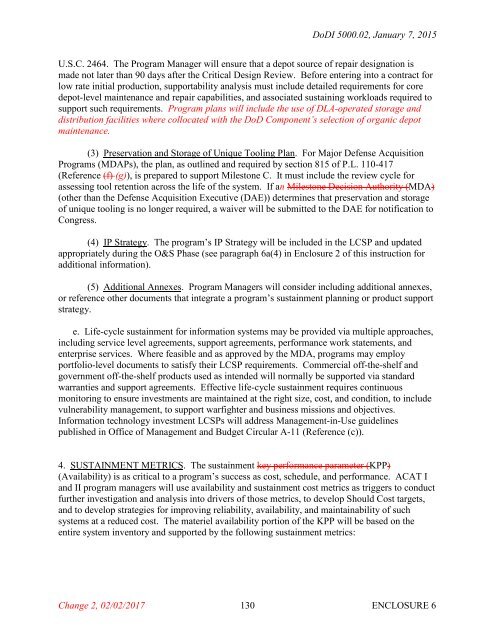Department of Defense INSTRUCTION
x9tnk
x9tnk
You also want an ePaper? Increase the reach of your titles
YUMPU automatically turns print PDFs into web optimized ePapers that Google loves.
DoDI 5000.02, January 7, 2015<br />
U.S.C. 2464. The Program Manager will ensure that a depot source <strong>of</strong> repair designation is<br />
made not later than 90 days after the Critical Design Review. Before entering into a contract for<br />
low rate initial production, supportability analysis must include detailed requirements for core<br />
depot-level maintenance and repair capabilities, and associated sustaining workloads required to<br />
support such requirements. Program plans will include the use <strong>of</strong> DLA-operated storage and<br />
distribution facilities where collocated with the DoD Component’s selection <strong>of</strong> organic depot<br />
maintenance.<br />
(3) Preservation and Storage <strong>of</strong> Unique Tooling Plan. For Major <strong>Defense</strong> Acquisition<br />
Programs (MDAPs), the plan, as outlined and required by section 815 <strong>of</strong> P.L. 110-417<br />
(Reference (f) (g)), is prepared to support Milestone C. It must include the review cycle for<br />
assessing tool retention across the life <strong>of</strong> the system. If an Milestone Decision Authority (MDA)<br />
(other than the <strong>Defense</strong> Acquisition Executive (DAE)) determines that preservation and storage<br />
<strong>of</strong> unique tooling is no longer required, a waiver will be submitted to the DAE for notification to<br />
Congress.<br />
(4) IP Strategy. The program’s IP Strategy will be included in the LCSP and updated<br />
appropriately during the O&S Phase (see paragraph 6a(4) in Enclosure 2 <strong>of</strong> this instruction for<br />
additional information).<br />
(5) Additional Annexes. Program Managers will consider including additional annexes,<br />
or reference other documents that integrate a program’s sustainment planning or product support<br />
strategy.<br />
e. Life-cycle sustainment for information systems may be provided via multiple approaches,<br />
including service level agreements, support agreements, performance work statements, and<br />
enterprise services. Where feasible and as approved by the MDA, programs may employ<br />
portfolio-level documents to satisfy their LCSP requirements. Commercial <strong>of</strong>f-the-shelf and<br />
government <strong>of</strong>f-the-shelf products used as intended will normally be supported via standard<br />
warranties and support agreements. Effective life-cycle sustainment requires continuous<br />
monitoring to ensure investments are maintained at the right size, cost, and condition, to include<br />
vulnerability management, to support warfighter and business missions and objectives.<br />
Information technology investment LCSPs will address Management-in-Use guidelines<br />
published in Office <strong>of</strong> Management and Budget Circular A-11 (Reference (c)).<br />
4. SUSTAINMENT METRICS. The sustainment key performance parameter (KPP)<br />
(Availability) is as critical to a program’s success as cost, schedule, and performance. ACAT I<br />
and II program managers will use availability and sustainment cost metrics as triggers to conduct<br />
further investigation and analysis into drivers <strong>of</strong> those metrics, to develop Should Cost targets,<br />
and to develop strategies for improving reliability, availability, and maintainability <strong>of</strong> such<br />
systems at a reduced cost. The materiel availability portion <strong>of</strong> the KPP will be based on the<br />
entire system inventory and supported by the following sustainment metrics:<br />
Change 2, 02/02/2017 130<br />
ENCLOSURE 6


